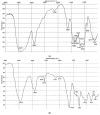Bacterial Nanocellulose Nitrates
- PMID: 31783661
- PMCID: PMC6955816
- DOI: 10.3390/nano9121694
Bacterial Nanocellulose Nitrates
Abstract
Bacterial nanocellulose (BNC) whose biosynthesis fully conforms to green chemistry principles arouses much interest of specialists in technical chemistry and materials science because of its specific properties, such as nanostructure, purity, thermal stability, reactivity, high crystallinity, etc. The functionalization of the BNC surface remains a priority research area of polymers. The present study was aimed at scaled production of an enlarged BNC sample and at synthesizing cellulose nitrate (CN) therefrom. Cyclic biosynthesis of BNC was run in a semisynthetic glucose medium of 10-72 L in volume by using the Medusomyces gisevii Sa-12 symbiont. The most representative BNC sample weighing 6800 g and having an α-cellulose content of 99% and a polymerization degree of 4000 was nitrated. The nitration of freeze-dried BNC was performed with sulfuric-nitric mixed acid. BNC was examined by scanning electron microscopy (SEM) and infrared spectroscopy (IR), and CN was explored to a fuller extent by SEM, IR, thermogravimetric analysis/differential scanning analysis (TGA/DTA) and 13C nuclear magnetic resonance (NMR) spectroscopy. The three-cycle biosynthesis of BNC with an increasing volume of the nutrient medium from 10 to 72 L was successfully scaled up in nonsterile conditions to afford 9432 g of BNC gel-films. CNs with a nitrogen content of 10.96% and a viscosity of 916 cP were synthesized. It was found by the SEM technique that the CN preserved the 3D reticulate structure of initial BNC fibers a marginal thickening of the nanofibers themselves. Different analytical techniques reliably proved the resultant nitration product to be CN. When dissolved in acetone, the CN was found to form a clear high-viscosity organogel whose further studies will broaden application fields of the modified BNC.
Keywords: Medusomyces gisevii; bacterial nanocellulose; carbon nanomaterials; cellulose nitrates; nitration; nitric-sulfuric acids; scale-up; surface morphology.
Conflict of interest statement
The authors declare no conflict of interest.
Figures





References
-
- Gama M., Dourado F., Bielecki S., editors. Bacterial Nanocellulose: From Biotechnology to Bio-Economy. Elsevier; Oxford, UK: 2016. p. 260.
-
- Khan S., Ul-Islam M., Khattak W.A., Ullah M.W., Park J.K. Bacterial cellulose-titanium dioxide nanocomposites: Nanostructural characteristics, antibacterial mechanism, and biocompatibility. Cellulose. 2014;22:565–579. doi: 10.1007/s10570-014-0528-4. - DOI
Grants and funding
LinkOut - more resources
Full Text Sources
Miscellaneous

